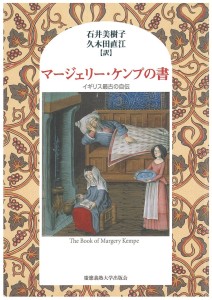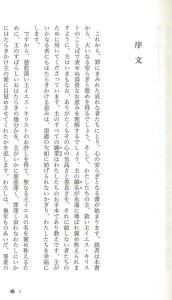In early September I attended the conference, ‘Medicine of Words: Literature, Medicine, and Theology in the Middle Ages’, held at St Anne’s College, Oxford. There I had a privilege to meet Professor Corinne Saunders, who gave a very exciting plenary lecture with her colleague, Dr Charles Fernyhough, a psychologist, as part of their Wellcome-funded Hearing the Voice Project. Their lecture, entitled ‘Reading Margery Kempe’s Inner Voices’, is very relevant to my experience of translating Margery’s inner voices into Japanese (2009).
The popularity of Margery’s book is attested by the recent modernised version of the book by Anthony Bale (2015). This extraordinary text attracts scholars from a variety of disciplines ranging from theology and devotional literature to gender and political studies. In their lecture, Professor Saunders’ and Dr Fernyhough’s central concern is psychological, focusing on Margery’s inner voices, which Barry Windeatt, in his Introduction to A Companion to the Book of Margery Kempe (2004), asserts to be central to interpretations of the Book.
Drawing on the Russian psychologist L. S. Vygotsky’s (1896-1934) ideas about the sociology of consciousness, Professor Saunders and Dr Fernyhough emphasise the importance of the dialogic nature of the higher mental functions and consider the process in which social dialogue is internalised into private speech, culminating in inner speech (i.e. internalisation). In exploring Margery’s inner voices, they have established two systems of ‘mind in dialogue’ by which inner speech is generated:
- ‘me as interlocutor’, interacting with ‘me as speaker’ (& vice versa)
- ‘God’, interacting with ‘me as speaker’ (& vice versa)
Furthermore, they argue that Margery’s mind in dialogue moves from a ‘condensed’ state to an ‘expanded’ state. In the condensed state, Margery embraces a sense of being with God through meditative experience, while in the expanded state, God and Margery mutually interact.
In my study on the Book of Margery Kempe (Margery Kempe’s Meditations: The Context of Medieval Devotional Literature, Liturgy and Iconography, 2007), I argue that the Book presents the reader with a creative experience of memory in which meditation functions as a spiritual mnemonic. Margery embeds meditations in the chronological movement of her life. The meditations can be categorised into two kinds of experience: one that appears as a scene or a well-defined sequence with the use of visual imagination; the other as meditative colloquies between Christ and Margery. The spiritual interlocution is the means by which Margery grows in her awareness of how her life is bound with Christ. Professor Saunders and Dr Fernyhough contend in their lecture that the dialogic nature of mental functions is exemplified by Margery’s interlocution with Christ and that her mind in dialogue functions as a conduit of her inner voices.
For the Japanese edition of the Book of Margery Kempe (on which I worked with my senior colleague, Mikiko Ishii), following discussions with the editor of Keio University Press, we decided to use ‘I’ instead of ‘she (and this creature)’ throughout the translation. Indeed, in 2002 Japanese scholar Noriko Matsui, who specialised on Sir Gawain and the Green Knight contributed her translation of the proem and chapters 1-7 of book one to an anthology of medieval visionary writings. She chose to produce a literal translation of the text. The translation itself is a fine work, but in my view it reads rather awkwardly. This is because the use, in her translation into Japanese, of the third person singular (as well as ‘this creature’) over-emphasises the clerical overtone. I think of the Book of Margery Kempe as autobiographical (or auto-hagiographical) rather than as fictitious, and the use of the third person singular in the Japanese translation may confuse the reader’s understanding of Margery’s ‘inner voices’. Thus, in order to foreground the ‘I’ voice embedded in Margery’s text, my co-editor and I chose to use the first-person singular in our Japanese translation.
It is also noteworthy that in Japanese literary writing as well as oral communication, the subject is often omitted in sentences. Once a narrative has started, we do not usually repeat the subject unless it is vital to specify it. In other words, we understand the subject in action through the context. This means that in the case of the Japanese translation of the Book, even if we use ‘I’ in the translation, the ‘I’ is very frequently hidden underneath the text. Thus the reader is listening to Margery relate her account, and the reader is able to hear her inner voices if disposed to do so.
Considering the idiosyncratic nature of Japanese, I chose the first-person singular as a compromise. But as a student of late medieval English literature, I cannot help but regret abandoning ‘this creature’, the epithet which conveys intimacy between Margery and her Creator. Nevertheless, the argument put forward by Professor Sauders and Dr Fernyhough concerning the role that ‘me as speaker/interlocutor’ plays in Margery’s mind in dialogue with God may well justify our practice in the translation.




